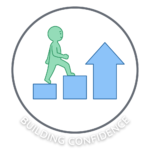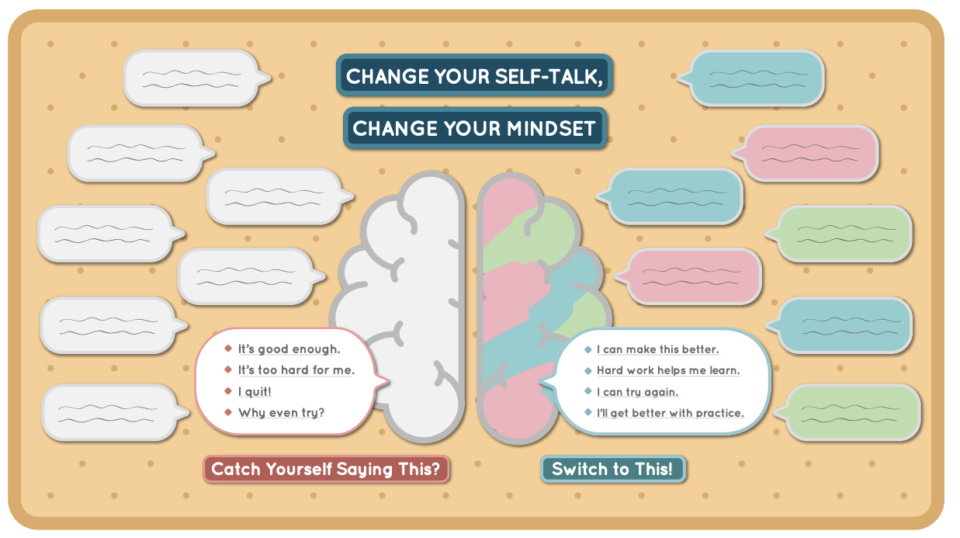
High school is a pivotal time for students as they navigate academic pressures, social dynamics, and personal growth. One of the most impactful tools a high school counselor can offer is the power of positive self-talk. By transforming negative self-talk into positive affirmations, students can shift their mindset from fixed to growth-oriented. A visually engaging bulletin board can serve as a daily reminder for students to practice this important skill. In this blog post, we will explore how to create and use a Self-Talk Bulletin Board for High School Counselors to help students enhance their self-esteem and mindset.

Why Positive Self-Talk Matters
Positive self-talk is crucial for students because:
- It Enhances Self-Esteem: Encourages students to view themselves in a positive light.
- It Promotes a Growth Mindset: Helps students embrace challenges and view failures as opportunities for growth.
- It Reduces Anxiety and Stress: Provides a calming effect during stressful situations.
- It Improves Academic Performance: Motivates students to persist in their efforts and achieve their goals.
Introducing the Self-Talk Bulletin Board
The “Self-Talk Bulletin Board” is designed to help students recognize and replace negative self-talk with positive affirmations. The board is divided into two sections: “Catch Yourself Saying This” and “Switch to This.” Each section includes speech bubble examples of negative and positive self-talk, respectively. By visually contrasting these statements, students can better understand how to transform their inner dialogue.
Instructions for Creating the Bulletin Board
Materials Needed
- Bulletin board
- Scissors
- Markers or pens
- Glue or tape
- Printable speech bubbles with self-talk examples
Duration
60-90 minutes
Activity Steps
Prepare the Bulletin Board Pieces (15 minutes)
Print and cut out the images and speech bubbles from Everyday Speech’s Bulletin Board bundle.
Assemble the Pieces (10 minutes)
Arrange and attach the speech bubbles to their respective sections on the bulletin board. Make sure the negative and positive self-talk examples are easy to read and visually distinct.
Introduce the Bulletin Board to Students (10 minutes)
Explain the purpose of the bulletin board to your students. Discuss the difference between a fixed mindset and a growth mindset, and how positive self-talk can help shift their mindset. Encourage them to actively use the board as a reference.
Examples of Self-Talk
Catch Yourself Saying This (Negative Self-Talk)
- “I can’t do this.”
- “I’m not smart enough.”
- “I always mess up.”
- “This is too hard.”
Switch to This (Positive Self-Talk)
- “I can try my best.”
- “I am capable of learning.”
- “Mistakes help me improve.”
- “I can overcome this challenge.”
Unlock all of our high school materials by signing up for your free trial today – no credit card required!
Access the full Social Communication Curriculum HERE!
Instant access to thousands of no-prep social skills activities, over 1000+ video lessons, and engaging games designed to enhance learning and development.
Conclusion
Helping high school students transform their self-talk is a powerful way to enhance their self-esteem and foster a growth mindset. Using a visually engaging Self-Talk Bulletin Board for High School counselors can effectively illustrate the difference between negative and positive self-talk, providing students with practical strategies to shift their mindset. By following the step-by-step instructions and incorporating the no-prep activity ideas, counselors can create a comprehensive and supportive learning experience. For more resources and tips on supporting students’ social-emotional learning, stay tuned to our blog.
Sample Video
Try out this sample animated video lesson.
We offer our entire Social-Emotional Learning platform free for 14 days here!
Related Blog Posts:
Teaching High School Students to Make Connected Comments in Conversations
Am I Ready to Date? A Guide for High School Students and Educators
Social Communication Curriculum





